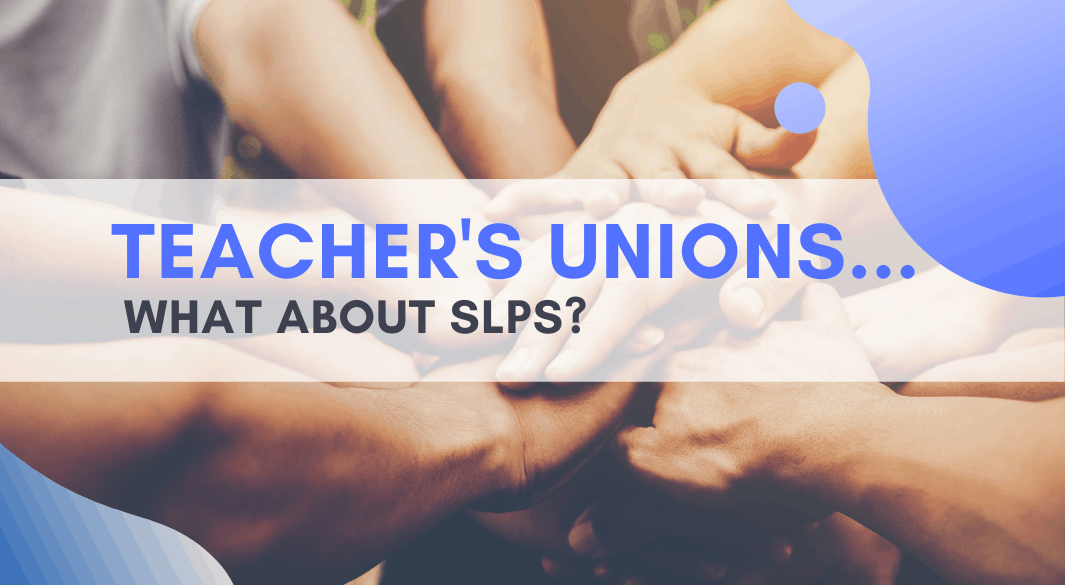If you work in the public schools as an SLP, you have probably been approached at some point about joining the union in your district.
As school-based, speech-language pathologists we have a place in educators’ unions, and we should be informed and active members that exercise our collective power to fulfill the promise of public education to prepare every student to succeed.
What are unions?
A union is an organized group of workers who come together to make decisions about the conditions that affect their work. They use their collective voice to make a positive impact; in other words, it is easy to ignore 1 employee out of 100. It is impossible to ignore all 100 of them speaking together.
There are many unions working for students and professionals in the United States. The largest is the National Education Association (NEA). In fact, the NEA is the largest union in the United States with around 2,300,000 members.
The second largest? It is also for educators: The American Federation of Teachers (AFT).
These two are the best known, but there are many others groups and organizations with local, state, and regional presence.
Are they worth it?
As an education professional, you probably care about your students and their quality of life. You also probably care about your own working conditions, compensation, and quality of life.
Those two things probably lead you to ask the following questions:
Do educator’s unions benefit professionals?
And
Do educator’s unions benefit students?
Joshua Cowen and Katharine Stunk published a nice meta-analysis of more than 30 years of research on teacher’s unions in the United States, looking at their impact on outcomes for professionals and students.
Do educator’s unions benefit professionals?
The research (as most good research does) gives us some complicated information. One tidbit they found that “average teacher salaries and payment for fringe benefits may be higher in unionized districts…as least as high as 5%.” (Cowen & Strunk, 2015). Of course, the picture isn’t that neat as “everyone gets a higher salary.” Their research found that experienced teachers tended to benefit most in terms of salary from the union.
Another study from 2011 found that teachers’ unions tend to “increase starting salaries” and “increase fringe benefits” (West & Mykerezi, 2011). The most interesting part of this study, for me, was how it looked at salary schedules overall. “Unions are able to use their collective bargaining power to increase all aspects of teacher pay and to compress the salary schedule so that it takes fewer years for teachers to reach the maximum salary.” (West & Mykerezi, 2011).
Salaries and contract benefits aside, there are other immediate benefits of union membership. For example, as a member of the National Educators’ Association you receive a pretty comprehensive liability protection plan including up to $3,000,000 in legal protection if civil proceedings are brought against you in the course of performing your educational employment activities. This is pretty similar coverage to many professional liability insurance policies that individual clinicians purchase.
While there are other tangible benefits of union membership, I think some of the most important are a little less concrete. The biggest benefit is the ability to band together with other professionals and have a say in how things are handled at all levels. This is usually referred to as collective bargaining; it is the heart and soul of union membership.
Does educator’s unions benefit students?
How educator unions affect students is less clear.
There is some research, including one of the studies I cited above, that indicates that unions don’t do much to boost student test scores and graduation rates (Cowen & Strunk, 2015). While it is certainly worth-while to help more students graduate, standardized test scores are not really the best indicator of educational outcomes in terms of union impact. This is especially true when considering other political and economic forces at work (Weiner).
A study released in 2020 found that when districts received state aid through finance reform, those with stronger unionization got more of that money into schools and classrooms and improved student outcomes. Those districts with weaker unions? The money went into reducing property taxes with little help given to schools.
Another way to see how unions benefit teachers is to look at what unions are fighting for. For example, In 2019, teachers in Oakland authorized a strike. Among their list of demands? Smaller class sizes. When the strike ended weeks later, they succeeded in reducing class sizes.
Look at the policies that the National Educator’s Association is fighting for:
The American Federation of Teachers wants to make sure students and their families have access to affordable health insurance. They want universal child care for students to be taken care of when they’re away from home.
Regardless of it is the NEA or the AFT, the facts and principles behind these issues and policies deserve our attention and support.
What about the dues?
I get it.
The dues are a lot. I’m not going to lie and pretend they’re not. I’m not going to write something annoying and patronizing like “that’s only one dinner out a month” or “if you make your own coffee at home you can afford your dues and a vacation home in the Bahamas.”
Pah-lease. My Starbucks habit is real.
Dues for the NEA average $50 a month! That could easily cover your car insurance, cell phone bill, or your online shopping addictions.
But you know what? I view my Union Dues as an investment in protecting my future and that of my students. Truly.
Look back up at the list of things the NEA is fighting for. Those things matter. And they matter enough for me to put my money where my mouth is and fund an organization that fights for them.
What if you want to get involved?
If you’re an employee of a school district, ask around to find out which union is active in your district. The NEA and AFT are the largest educator unions, but there are others that may be active in your area.
Ask a colleague or reach out to an administrator about which union is active in your school.
Recommended Reading
In 2010 ASHA published a great resource for SLP’s and AuDs how to negotiate with school unions and school administrators to advocate for identified individual and local needs. Check it out here: https://www.asha.org/siteassets/uploadedFiles/Working-Change-Schools-SLPs-Audiologists-Guide.pdf
Another great resource is the book The Future of Our Schools: Teachers Unions and Social Justice by Professor Lois Weiner.
I’m a big fan of NPR and this piece, even though it is eight years old, is a great look at unions in general: https://www.npr.org/2012/06/07/154519830/which-workers-need-unions-and-which-dont
Finally, there is the academic research literature I cited above.



1 thought on “Teacher’s Unions – Just for teachers?”